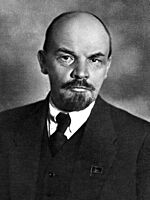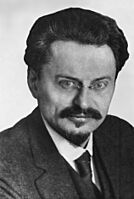History of the Soviet Union facts for kids
The history of Soviet Russia and the Soviet Union (USSR) was a time of big changes for Russia and the whole world. When people say "Soviet Russia," they usually mean the short time between the October Revolution of 1917 and the creation of the Soviet Union in 1922. The "Soviet Union" (USSR) was a much larger country that existed from 1922 to 1991.
Before 1922, there were four main Soviet Republics: the Russian Soviet Federative Socialist Republic, Ukrainian Soviet Socialist Republic, Byelorussian SSR, and Transcaucasian SFSR. These four joined together to form the first parts of the Soviet Union. Later, other republics joined too. After World War II, the USSR grew even larger, taking in parts of Eastern Europe and some islands from Japan. It also added three countries near the Baltic Sea: Lithuanian SSR, Latvian SSR, and Estonian SSR.
The Soviet Union had a lot of influence over other Communist countries, especially after World War II. It helped set up Communist governments in countries like East Germany, Poland, and Hungary. These countries formed a group called the Warsaw Pact. But over time, some of these countries started to disagree with the Soviet Union. By 1989, many of these Communist governments ended their rule.
Eventually, the different parts of the Soviet Union wanted to be independent. This led to the complete breakup of the Soviet Union by 1991.
Contents
1917–1927: How the Soviet Union Began
The main ideas behind the Soviet Union came from the writings of Karl Marx and Friedrich Engels. Marx believed that societies would naturally change from a system where people owned businesses (called capitalism) to a system where the government controlled everything for the good of everyone (called socialism).
Russia was a place with many new ideas after the Russian Revolution of 1905. People were unhappy with the Tsar (the emperor). A big socialist group, the Russian Social Democratic Labour Party (RSDLP), followed Marx's ideas. This party split into two main groups: the Bolsheviks, led by Vladimir Lenin, and the Mensheviks, led by Julius Martov. The Bolsheviks were the "majority" and the Mensheviks were the "minority."
In 1917, after another revolution called the February Revolution of 1917, the Tsar was removed. A new government was set up, but it shared power with a group called the Petrograd Soviet. This "dual power" didn't last long. In October 1917, the Bolsheviks, led by Lenin, took control in what is known as the October Revolution. The Bolshevik party grew very quickly, from 24,000 members in February to 200,000 by September 1917.
Lenin's government brought in new ideas like education for everyone, universal healthcare, and equal rights for women. The Bolsheviks believed that their party represented the working class. They stopped any political ideas or groups that went against their beliefs.
From 1917 to 1924, the Soviet Union made peace with its enemies from World War I. But it also fought a difficult war called the Russian Civil War. The Bolsheviks fought against the White Army and armies from other countries like the United States and United Kingdom. The Bolsheviks won this war and spread their style of rule across Russia. After Lenin died in 1924, Joseph Stalin became the new leader of the Soviet Union. He remained in power until the 1950s.
1927–1953: The Time of Stalin
The period from 1927 to 1953 was when Joseph Stalin was the leader of the Soviet Union. This time included World War II, which the Soviet Union called "the Great Patriotic War." Stalin wanted to get rid of his political rivals. He also wanted to change Soviet society using a system called central planning. This meant the government controlled the economy. He forced farmers to join large collective farms (collectivization) and focused on building up heavy industries.
Stalin became very powerful. He created a "cult of personality," where people were taught to admire him greatly. He also used a secret police and encouraged mass mobilization, where many people were organized to support the government. The Communist Party was a key tool for Stalin to shape Soviet society.
Stalin's methods were harsh. He carried out "purges" to remove people he didn't trust from the party. He also used political repression against the general population. Millions of people died during this time. Some died in forced labor camps called Gulags, others from man-made famines, and some from forced movements of people based on their ethnic background.
World War II caused huge damage to the Soviet Union. About one out of every three deaths in World War II was a Soviet citizen. After the war, Soviet armies stayed in Central and Eastern Europe. Socialist governments were set up in these countries. By 1949, the Cold War began. This was a long period of tension between the Western Bloc (led by the United States) and the Eastern Bloc (led by the Soviet Union). The Warsaw Pact was formed by the Soviet Union and its allies to stand against NATO in Europe. Stalin continued his strong rule until he died in 1953.
1953–1964: The Khrushchev Thaw
After Joseph Stalin died in 1953, Nikita Khrushchev became the new leader. This period, lasting until 1964, is known as the "Khrushchev Thaw." During this time, the Soviet Union's politics were heavily influenced by the Cold War. This was a struggle between the United States and the Soviet Union to show which country's way of life and economic system was better. Both countries also wanted to protect their areas of influence around the world.
Khrushchev started a process called De-Stalinization. This meant he criticized many of Stalin's harsh actions and tried to make the Soviet Union a less fearful place. However, some parts of Stalin's way of ruling remained. For example, the leader of the Communist Party still had a lot of power. The country also continued to use five-year plans to control the economy.
1964–1982: The Era of Stagnation
The period from 1964 to 1982 is called the Brezhnev Era, after its leader, Leonid Brezhnev. At the start, the Soviet economy was growing well. But by the end, the Soviet Union faced many problems in its society, politics, and economy. The average income stopped growing much because important economic changes were not made.
Nikita Khrushchev was removed from power in October 1964. This happened because his reforms didn't work well, and he didn't always respect the Party's rules. Brezhnev took over as the main leader. Alexei Kosygin became the head of the government. Other important leaders also shared power. This was a "collective leadership," meaning several people made decisions together, unlike Khrushchev's more individual rule.
The new leaders first tried to make the Soviet Union more stable and calm its people. They succeeded in this. They also tried to make the economy grow faster, as it had slowed down under Khrushchev. In 1965, Kosygin tried to make some economic changes to give local areas more control. These changes worked at first. But some powerful people in the Party stopped them. They worried that these changes would make the Party less important.
No other big economic changes happened during Brezhnev's time. Economic growth started to slow down in the early 1970s. By the time Brezhnev died in 1982, many historians say the Soviet economy had almost stopped growing.
The policy of stability meant that older leaders stayed in power for a long time. Also, political corruption became common. Brezhnev did not try to stop this corruption on a large scale. The Soviet Union built up a very strong military in the 1960s. This helped it become a superpower during Brezhnev's rule. The era ended when Brezhnev died on November 10, 1982.
While other modern countries were quickly using computers after 1965, the Soviet Union fell behind. They decided to copy an old computer system from 1965. This made it hard for their scientists to improve it. They also had trouble making computer parts and writing good programs.
One of the Soviet economy's biggest strengths was its huge supplies of oil and gas. When world oil prices went up a lot in the 1970s, selling oil and gas became the main way the Soviet Union made money. This money helped cover up other problems in the economy. It also helped pay for military spending and allowed the Soviet Union to take part in risky foreign actions, like the war in Afghanistan.
1982–1991: Reforms and the End of the Soviet Union
The final years of the Soviet Union, from 1982 to 1991, began after Leonid Brezhnev's death. Attempts to fix the country's problems didn't work. The economy was stuck, and the Soviet Union was struggling in the Soviet–Afghan War. All these things led to a lot of unhappiness, especially in the Baltic states and Eastern Europe.
The last Soviet leader, Mikhail Gorbachev, brought in more political and social freedoms. This allowed people to openly criticize the government. A big drop in oil prices in 1985 and 1986 also deeply affected the Soviet leadership.
More and more Soviet Socialist Republics started to resist control from the central government. As people gained more freedom, the central government became weaker. The Soviet Union was also running out of money because it was spending more than it earned from trade.
The Soviet Union finally collapsed in 1991. This happened after a failed attempt to remove Gorbachev from power. After the coup failed, Boris Yeltsin took control, and the Soviet Union officially ended.
See also
 In Spanish: Historia de la Unión Soviética para niños
In Spanish: Historia de la Unión Soviética para niños
- Foreign relations of the Soviet Union
- Islam in the Soviet Union
- Index of Soviet Union–related articles
- Ukrainian nationalism



